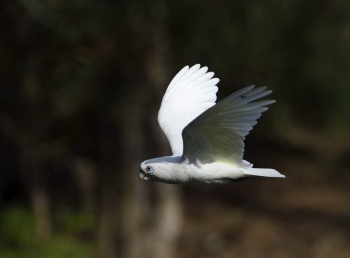- Cacatua pastinator
Identification
45cm.
- overall white
- lores orange/red
- bases of feathers on head and mantle down to flanks washed with pink/orange.
- eye ring grey/blue, bare. More extensive beneath the eye.
- eye dark brown.
- underparts, under wing and undertail are washed pale yellow
- bill slender and horn-coloured with a long upper mandible: hooked
- legs and feet grey
Sexes similar.
Similar species
Similar to Little Corella and Long-billed Corella where those species occur in South West Australia (especially Perth area).
Compared with Little, Western has (differences in descending order):
- bill longer than little. Long-billed individuals of Little may approach the length of Western if Western's bill is worn
- larger size (around 7 cm)
- bases of the throat feathers more extensively red in Western (may be difficult to see)
- crest is slightly longer than little, but the difference is not great
- loral orange/pink is similar in both species but perhaps slightly more saturated and extensive in Western
See Long-billed Corella for comparison with that species.
Distribution
Australian endemic only found in Western Australia.
Taxonomy
Subspecies
There are two subspecies
- C. p. derbyi: Western Australia (Dongara to Moora and Quairading). [Smaller than pastinator]
- C. p. pastinator: South-western Western Australia (Lake Muir and Unicup region). [Larger than derbyi]
Habitat
Near water courses, grassy woodlands and where seeding grasses are found.
Behaviour
Diet
They feed mainly on the ground; the diet includes cereal grains, grasses and exotic weeds, bulbs and germinating cereals, insects and their larvae.
Breeding
The nest is in a hole in tree, mainly in native Eucalyptus, lined with woodchips. 2 - 3 eggs are laid and are incubated for 22 to 26 days, by both parents. The young are cared for by both parents, and fledge at about 8 weeks.
References
- Clements, J. F., T. S. Schulenberg, M. J. Iliff, D. Roberson, T. A. Fredericks, B. L. Sullivan, and C. L. Wood. 2014. The eBird/Clements checklist of birds of the world: Version 6.9., with updates to August 2014. Downloaded from http://www.birds.cornell.edu/clementschecklist/download/
Recommended Citation
- BirdForum Opus contributors. (2024) Western Corella. In: BirdForum, the forum for wild birds and birding. Retrieved 26 October 2024 from https://www.birdforum.net/opus/Western_Corella





